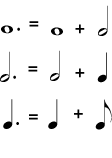| << Chapter < Page | Chapter >> Page > |
A half note is half the length of a whole note; a quarter note is half the length of a half note; an eighth note is half the length of a quarter note, and so on. (See Duration:Note Length .) The same goes for rests. (See Duration: Rest Length .) But what if you want a note (or rest) length that isn't half of another note (or rest) length?
One way to get a different length is by dotting the note or rest. A dotted note is one-and-a-half times the length of the same note without the dot. In other words, the note keeps its original length and adds another half of that original length because of the dot. So a dotted half note, for example, would last as long as a half note plus a quarter note, or three quarters of a whole note.

Make groups of equal length on each side, by putting a dotted note or rest in the box.


A note may have more than one dot. Each dot adds half the length that the dot before it added. For example, the first dot after a half note adds a quarter note length; the second dot would add an eighth note length.

A dotted half lasts as long as a half note plus a quarter note. The same length may be written as a half note and a quarter note tied together. Tied notes are written with a curved line connecting two notes that are on the same line or the same space in the staff. Notes of any length may be tied together, and more than two notes may be tied together. The sound they stand for will be a single note that is the length of all the tied notes added together. This is another way to make a great variety of note lengths. Tied notes are also the only way to write a sound that starts in one measure and ends in a different measure.

Dots and ties give you much freedom to write notes of varying lengths, but so far you must build your notes from halves of other notes. If you want to divide a note length into anything other than halves or halves of halves - if you want to divide a beat into thirds or fifths, for example - you must write the number of the division over the notes. These unusual subdivisions are called borrowed divisions because they sound as if they have been borrowed from a completely different meter . They can be difficult to perform correctly and are avoided in music for beginners. The only one that is commonly used is triplets , which divide a note length into equal thirds.


Notes in jazzy-sounding music that has a "swing" beat are often assumed to be triplet rhythms, even when they look like regular divisions; for example, two written eighth notes (or a dotted quarter-sixteenth) might sound like a triplet quarter-eighth rhythm. In jazz and other popular music styles, a tempo notation that says swing usually means that all rhythms should be played as triplets. Straight means to play the rhythms as written.


Notification Switch
Would you like to follow the 'Reading music: common notation' conversation and receive update notifications?